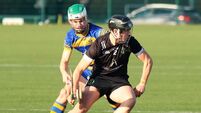Wrestling with the early rules of Gaelic football

When was Gaelic football invented?
It is tempting to answer that it was invented on this week in January 1885, when the newly formed GAA wrote down a short list of rules for the game which came to be known as Gaelic football.
Football — in various forms — had been played in Ireland for centuries before this, of course. It was played in many localities and under varying sets of rules (and, it would appear, it was also played under no rules at all).
The emergence of Gaelic football as we know it today was a product of the Victorian sporting revolution which took traditional forms of play and squeezed them into modern playing fields.
The first evidence of that happening with football in Ireland came through the establishment of a Rugby Football Club at Trinity College Dublin in the 1850s.
Later, at the end of the 1870s, association football (or soccer) made its first formal appearance in Ireland. Alongside these games, traditional football matches were played in various localities.
It was from a mixture of these influences that the GAA forged the game which it called Gaelic football.
It should not be considered that the divides between these games were as distinct as they are now. This was a world very much in the making. There were two sporting weekly newspapers published in Ireland in the 1880s: Sport and The Irish Sportsman.
The reports of football matches carried in those papers demonstrate the confusion which surrounded rules during this period.
On New Year’s Day, 1881, Sport reported that a team called Gitanos had travelled west to Longford to play a team drawn from the counties of Longford and Roscommon. The scenes witnessed by the journalist were wonderful:
“The snow lay about half a foot deep on the field, which afforded the rustics excellent amusement, for they soon had the place studded with snowballs approaching the size of an ordinary sea buoy, while others of smaller dimensions were playfully used as missiles against the invaders.
“All went well until the first Roscommon man was tackled and thrown. This, through some misconception by the rustics who had never seen the game before, was construed into an assault and they, determined not ‘to see a Roscommon man beat’, rushed in on the ground and knocked over a couple of Dublin men.
“The Roscommon players, of course, took the visitors’ part, and a free fight all round was prevented with difficulty. Several more rows took place during the progress of play, and but for the energetic interference of Dr. Cochrane, JP, and Captain Jones, JP, who played for Roscommon, the consequences might have been serious.
“Messrs O’Kelly and McIntosh of the Visitors team, were so much hurt that they were unable to play to any effect. The match resulted, according to the umpire, in a victory for Roscommon by two goals to one goal.
“The visitors were most hospitably entertained by the Strokestown FC at dinner in the Longford Arms Hotel. After the usual loyal and other toasts had been duly honoured Mr McCarthy proposed the toast of ‘the development of football in Connaught and the organisation at no distant date of a Connaught provincial fifteen to play in the annual interprovincial matches’. After several excellent speeches, songs, recitations, etc, the Dublin men returned to town by the 1am train.”
Before rugby or football could properly establish itself in Connacht — or before any proper attempt was made to establish it by the Belfast- and Dublin-centric rugby alickadoos — the GAA came in with its new game of Gaelic football.
When the second meeting of the GAA was held in the Victoria Hotel in Cork on Saturday, December 27, 1884, Maurice Davin, as the association’s new president, was asked to head a committee, which included the secretaries of the GAA (Michael Cusack, John McKay, and John Wyse Power), to draft the GAA’s rules for athletics, hurling, and Gaelic football.
As it turned out, it appears Davin went about drafting the rules largely on his own. It was a job he was well-placed to do. A detailed notebook which he kept during the 1870s and 1880s contains notes and newspaper cuttings on the rules and organisation of English athletics, as well as notes on the rules and terminology for soccer.
At the third GAA meeting — held in Thurles on January 17, 1885 — Davin presented a set of rules which were unanimously adopted.
The rules were published in the United Ireland on February 10, 1885, and were later reprinted in pamphlet form in early May at the cost of 6d.
Ultimately, the game of football invented by Davin was supposed to stand in opposition to rugby and soccer. In practice, Davin’s new football rules borrowed from both existing games. For example, when a ball was kicked out over the sideline by one team, a throw-in was awarded to the opposition, as was the case in soccer.
There should be no surprise in this imitation — after all, this was just another form of football to put beside the ones that already existed. Davin’s desire was to make rules for a “fine manly game”, one which was not as vicious as rugby, a sport which he considered “brutal and demoralising”.
The rules constructed for this new game, which quickly became known as ‘Gaelic’ football, were relatively vague and, as well as being influenced by the rules of modern sport, also made a nod to traditional Irish ways of play — to this end, the game allowed for players to break away from the play and engage in wrestling matches.
The first match played under GAA rules was a football one: A large crowd turned out in Callan, Co. Kilkenny, to see the home team play against a team from Kilkenny city on February 15, 1885. The match ended in a scoreless draw.
It was obvious the game needed to be opened out a little to allow for more scoring opportunities. And so it was that in 1886 the tradition of players breaking off and wrestling as the game progressed around them was eventually (officially) ended when it was stated: “Wrestling and handigrips to be henceforth prohibited.”
News of this rule change has yet to reach certain sections of the association.
Back in 1886, banning wrestling led to a storm of complaint in the press, with letter writers complaining that the game had lost its manly aspect when stripped d of wrestling. This controversy continued for several years.
In the way of these things, various clubs and players ignored the fact wrestling was not permitted and continued regardless. Indeed, displays of strength were positively eulogised in reports of matches and in the reminiscences of those who attended them.
A local priest in Kerry, Rev John P Devane, wrote of a match in 1887: “The Captain would shout: ‘Follie the ball’, and follie it they did, like Foley’s beagles at a fox chase.”
And as this following of the ball went on, Fr Devane noted the tendency to play the man rather than the ball, especially when a side was losing. This was, he said, a most popular tactic with the crowd. And as if to emphasise the importance of strength, he recalled a match between Castleisland and Tralee at the Tralee Sportsfield — who won the match escaped him but he did recall ‘Foxy Tom’ throwing three Castleisland fellows in a heap out over the ropes.
In those first years of the GAA, the leading officials were never finished telling everyone just how disciplined the members of the GAA were. The problem was there was a sizeable amount of evidence to the contrary. And the press and public revelled in the fighting.
For example, when Ballyhale from Kilkenny played a football match against fellow-countymen Slieverue in 1887, the reporter in the County Tipperary Independent was so appalled at the “disgraceful scenes” that he felt compelled to offer an in-depth account.
Noting that the referee simply left the players at it when they started to fight, the reporter said that the entire match was little more than a faction fight. It got so bad that the Kilkenny county executive intervened and stopped the match by pulling up the goalposts.
Part of the issue was that those who had played games in the years before the establishment of the GAA were unused to referees. As the brilliant journalist PD Mehigan (Carberry) put it: “Inexperience in the conduct of organised games led to many disputes.”
More than that, referees were verbally abused before and after games on a routine basis. One referee recalled being “subjected to the most vile abuse from the very moment the match commenced”.
And there was also physical abuse: In Dublin, a referee was “severely beaten” by a player at a match in Clonskeagh in 1888. Then — as now — the frailties of human nature meant it was one thing to invent rules and to make a modern game. But it was altogether another thing to live by those rules.











